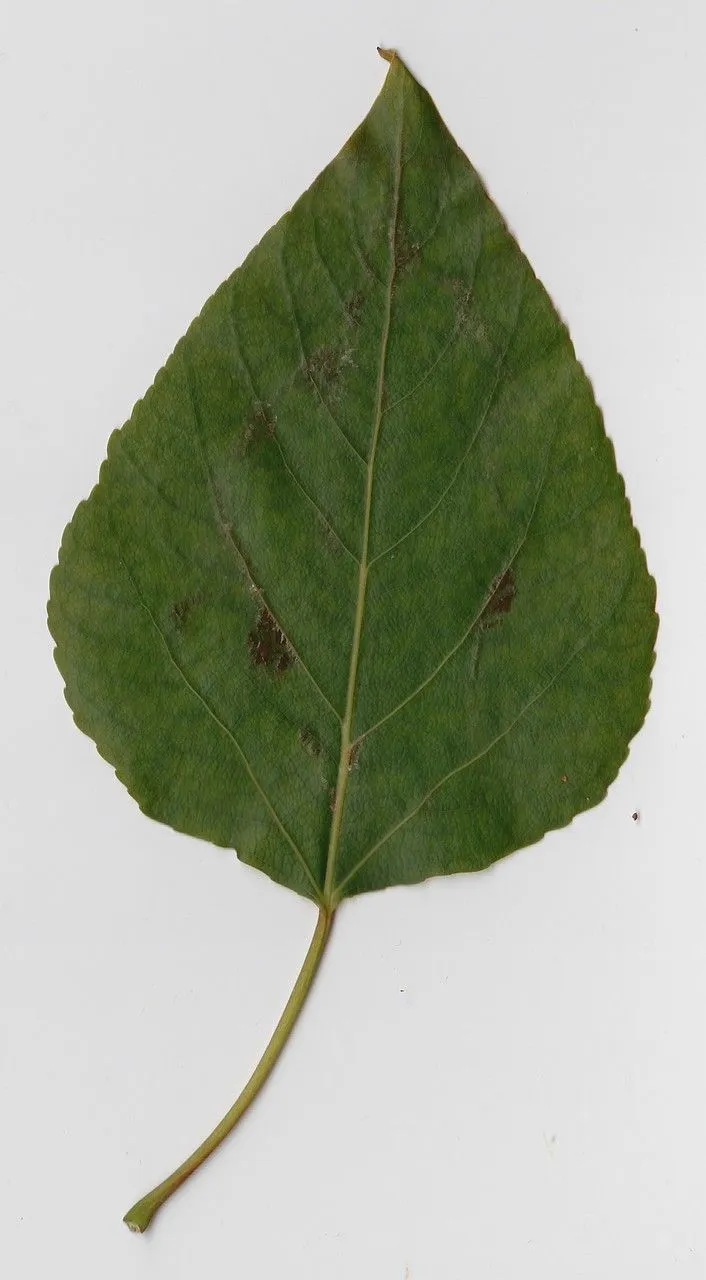
Author: Torr. & A.Gray ex Hook.
Bibliography: Torr. & A. Gray ex Hook. (1852). In: Ic. Pl, T. 878.
Year: Unknown
Status: accepted
Rank: species
Genus: Populus
Vegetable: Unknown
Observations: Unknown
Western balsam poplar (Populus trichocarpa) is a notable species belonging to the Salicaceae family. An impressive deciduous tree, it is native to the western regions of North America, thriving in both coastal and interior environments. Its preference for moist, well-drained soils allows it to dominate regions along rivers, streams, and floodplains, where it not only flourishes but also significantly contributes to the local ecosystem.
Characterized by its rapid growth, the Western balsam poplar can reach considerable heights, often growing up to 30 meters or more. The tree displays a robust and wide-spreading root system, providing stability and aiding in soil conservation. This species is distinguished by its broad, ovate leaves, which exhibit a vibrant green color on the upper surface and a lighter, almost silvery hue on the underside. The leaves turn a striking yellow in the fall, adding seasonal visual interest to the landscape.
Populus trichocarpa is also notable for its aromatic resin, a feature that has earned it the common name ‘balsam poplar.’ The resin, exuded from the buds, infuses the air with a balsamic scent, especially noticeable during the warmer months. Historically, indigenous peoples have utilized this resin for medicinal purposes, recognizing its soothing properties on the skin and its potential in treating various ailments.
Ecologically, the Western balsam poplar holds significant value. It provides essential habitat for a variety of wildlife, including birds, insects, and mammals, thus playing a pivotal role in maintaining biodiversity. The tree’s ability to rapidly colonize disturbed areas makes it an important species for restoration projects, particularly in riparian zones where stabilizing soil and controlling erosion are critical.
Although the Western balsam poplar is a well-studied species, certain aspects of its biology and ecological interactions remain under continuous research. Observations within its native habitat have contributed extensively to our understanding of its dynamics and the broader environmental impacts. Nevertheless, there continue to be unidentified elements and behaviors within its life cycle that invite further scientific exploration.
First described and classified by the distinguished botanists Torr. & A. Gray, with Hooker providing additional descriptive work in 1852, the Western balsam poplar has since been a subject of enduring interest within the botanical community. The detailed illustration and classification in “Ic. Pl, T. 878” provide an essential historical reference for understanding this species’ botanical characteristics.
In summary, Populus trichocarpa is more than just a tree; it’s a vital component of its ecosystem, admired for its aesthetic appeal, ecological importance, and historical utility. This remarkable species continues to be a focus of botanical study and an essential part of the natural heritage of western North America.
Eng: black cottonwood, western balsam-poplar, balsam cottonwood, balsam poplar, western balsam poplar
Deu: haarfrüchtige balsam-pappel, westliche balsam-pappel
Dan: vestamerikansk balsam-poppel, vestamerikansk poppel
Swe: jättepoppel, jättipoppeli
Fin: jättipoppeli
Nno: kjempepoppel
Nob: kjempepoppel
Nld: zwarte balsempopulier
Cym: poplys balmaidd y gorllewin, poplysen falmaidd y gorllewin, poplysen gilead y gorllewin
En: Western balsam poplar, Balsam poplar, Black cottonwood, Western Balsam-poplar, Balsam Cottonwood
Da: Vestamerikansk balsam-poppel, Vestamerikansk poppel
Nl: Zwarte balsempopulier
Fi: Jättipoppeli
Fr: Peuplier Baumier, Peuplier baumier de l’Ouest
De: Haarfrüchtige Balsam-Pappel, Westliche Balsam-Pappel, Balsampappel, Haarfrüchtige Pappel
Nb: Kjempepoppel
Nn: Kjempepoppel
Es: Chopo de Virginia
Sv: Jättepoppel, Jättipoppeli
Cy: Poplys Balmaidd y Gorllewin, Poplysen Falmaidd y Gorllewin, Poplysen Gilead y Gorllewin
Taken Apr 18, 2015 by Tela Botanica − Yoan MARTIN (cc-by-sa)
Taken Apr 18, 2015 by Tela Botanica − Yoan MARTIN (cc-by-sa)
Taken Apr 18, 2015 by Tela Botanica − Yoan MARTIN (cc-by-sa)
Taken Apr 22, 2012 by Tela Botanica − laëtitia goëau (cc-by-sa)
Taken Dec 25, 2021 by mohammad fazel dehkordi (cc-by-sa)
Taken Aug 2, 2021 by beattie trevor (cc-by-sa)
Taken Sep 10, 2015 by Tela Botanica − Michel GAUBERT (cc-by-sa)
Taken Sep 10, 2015 by Tela Botanica − Michel GAUBERT (cc-by-sa)
Taken Sep 10, 2015 by Tela Botanica − Michel GAUBERT (cc-by-sa)
Taken Apr 18, 2015 by Tela Botanica − Yoan MARTIN (cc-by-sa)
Taken Jun 21, 2021 by beattie trevor (cc-by-sa)
Taken Jul 10, 2005 by Tela Botanica − Annick LARBOUILLAT (cc-by-sa)
Taken Oct 23, 2021 by Atxa Mikel Atxa (cc-by-sa)
Taken Apr 18, 2015 by Tela Botanica − Yoan MARTIN (cc-by-sa)
Taken Apr 18, 2015 by Tela Botanica − Yoan MARTIN (cc-by-sa)
Taken May 1, 2017 by PHILIPP Beerschneider (cc-by-sa)
Taken Mar 15, 2005 by Photoflora – Jean-Luc TASSET (©)
Taken Mar 15, 2005 by Photoflora – Jean-Luc TASSET (©)
Taken Oct 30, 2006 by Tela Botanica − Annick LARBOUILLAT (cc-by-sa)
Taken Apr 22, 2012 by Tela Botanica − laëtitia goëau (cc-by-sa)
Taken Apr 22, 2012 by Tela Botanica − laëtitia goëau (cc-by-sa)
Taken Oct 30, 2006 by Tela Botanica − Annick LARBOUILLAT (cc-by-sa)
Taken Apr 22, 2012 by Tela Botanica − laëtitia goëau (cc-by-sa)
Taken Apr 27, 2022 by Henk Kole (cc-by-sa)
Family: Myrtaceae Author: (F.Muell.) K.D.Hill & L.A.S.Johnson Bibliography: Telopea 6: 402 (1995) Year: 1995 Status:…
Family: Rubiaceae Author: Pierre ex A.Froehner Bibliography: Notizbl. Bot. Gart. Berlin-Dahlem 1: 237 (1897) Year:…
Family: Sapindaceae Author: Koidz. Bibliography: J. Coll. Sci. Imp. Univ. Tokyo 32(1): 38 (1911) Year:…
Family: Asteraceae Author: A.Gray Bibliography: Pacif. Railr. Rep.: 107 (1857) Year: 1857 Status: accepted Rank:…
Family: Fabaceae Author: Medik. Bibliography: Vorles. Churpfälz. Phys.-Ökon. Ges. 2: 398 (1787) Year: 1787 Status:…
Family: Aspleniaceae Author: (Cav.) Alston Bibliography: Bull. Misc. Inform. Kew 1932: 309 (1932) Year: 1932…